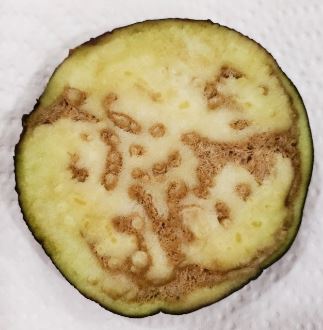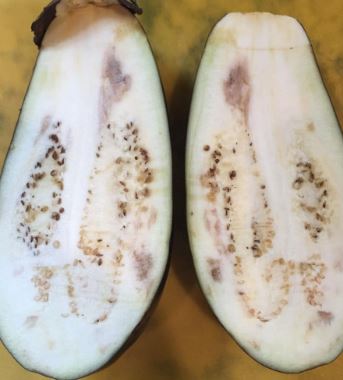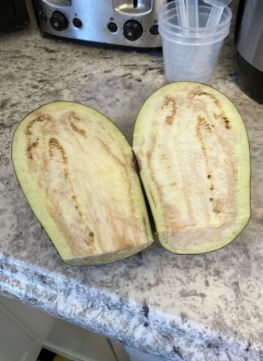Eggplants, with their glossy purple skin and versatile culinary uses, are a popular addition to many dishes. However, ensuring the freshness of an eggplant is crucial to avoid potential health risks and unpleasant dining experiences. In this guide, we will explore various signs of a bad eggplant inside, delve into the consequences of consuming spoiled eggplants, and provide practical tips on selecting and handling eggplants to maximize freshness.
Signs of a Bad Eggplant Inside
Color:
- When assessing an eggplant’s freshness, the first visual cue is its color. A healthy eggplant should have vibrant purple skin. If you notice any brown discoloration or soft spots, it could be a sign of spoilage. The brown hue indicates oxidation, which occurs as the eggplant deteriorates.
- To better understand the visual differences, refer to the following table:
Fresh Eggplant Spoiled Eggplant Purple and firm Brown and soft - Use this table as a quick reference when examining eggplants for freshness.

Smell:
- Another reliable indicator of a bad eggplant is its odor. A fresh eggplant should have a neutral, earthy scent. However, if you detect a sour or unpleasant smell, it’s a clear sign of spoilage. Trust your sense of smell to make an initial assessment before further inspection.
- Keep in mind that a bad odor may indicate the presence of harmful bacteria or mold, making the eggplant unsafe for consumption.
Texture:
- The texture of an eggplant is a crucial factor in determining its quality. Run your fingers over the skin and gently press on different areas. A fresh eggplant should feel firm and taut. If you encounter mushiness, sliminess, or excessive sponginess, it’s a strong indication that the eggplant is past its prime.
- Understanding the texture is essential, as it provides valuable insights into the overall condition of the eggplant’s flesh.
Skin:
- Inspecting the skin of an eggplant can reveal important clues about its freshness. A healthy eggplant will have smooth and shiny skin. However, if you observe wrinkling or a slimy texture on the skin, it suggests that the eggplant is no longer in optimal condition.
- The skin acts as a protective barrier, and any abnormalities on its surface may signify underlying issues with the flesh.
Bruising:
- Eggplants are susceptible to bruising, and these bruises can quickly turn bad, compromising the vegetable’s integrity. Carefully examine the eggplant for any visible bruises, especially if they appear dark or discolored. A bruised eggplant is more prone to spoilage and should be approached with caution.
- Avoid purchasing or consuming eggplants with extensive bruising, as they are likely to have accelerated deterioration.
Moisture:
- The moisture content of an eggplant is a key factor in maintaining its freshness. A healthy eggplant retains moisture, keeping the flesh succulent and appealing. Conversely, if you notice rapid moisture loss, leading to dry and pithy flesh, it’s a clear indication that the eggplant is past its prime.
- Moisture loss can also contribute to a lack of flavor and compromised texture, diminishing the overall culinary experience.
Visual Guide: Eggplant Bad Inside
Visual aids can be instrumental in recognizing the various signs of a bad eggplant. Refer to the images below to enhance your understanding:

Figure 1: Healthy, Fresh Eggplant

Figure 2: Eggplant with Signs of Spoilage
Use these images as reference points when assessing the color, texture, and overall condition of eggplants.
What Happens If You Eat Bad Eggplant
Digestive Issues:
- Consuming spoiled eggplant can lead to various digestive issues. If the eggplant harbors harmful bacteria or molds, it may cause stomach upset, nausea, and diarrhea. The body’s reaction to ingesting spoiled food can vary, but gastrointestinal discomfort is a common consequence.
- Individuals with sensitive stomachs or compromised immune systems should exercise extra caution when it comes to spoiled vegetables.
Toxins:
- In some cases, bad eggplants may produce toxins as they deteriorate. These toxins can be harmful when ingested and may lead to more severe health complications. While the likelihood of encountering toxic eggplants is relatively low, it underscores the importance of vigilant food safety practices.
- Avoiding the consumption of visibly spoiled eggplants is a crucial step in preventing potential toxin exposure.
Health Risks:
- The health risks associated with eating bad eggplants extend beyond immediate digestive discomfort. Prolonged exposure to spoiled or contaminated food can lead to foodborne illnesses, with symptoms ranging from mild to severe. Common risks include dehydration, fever, and in extreme cases, hospitalization.
- It is imperative to prioritize food safety and make informed decisions when it comes to the consumption of fresh produce.
Eggplant Brown Inside: Causes and Consequences
Oxidation
- One of the primary reasons eggplants turn brown inside is oxidation. When an eggplant is cut or damaged, enzymes within the vegetable react with oxygen in the air, resulting in the development of brown pigments. This natural process accelerates as the eggplant ages, leading to widespread discoloration.
- To minimize oxidation, it’s essential to use cut eggplant promptly or employ preservation methods to slow down the enzymatic browning process.
Enzymatic Browning

- Enzymatic browning is a biochemical reaction that occurs when the enzyme polyphenol oxidase (PPO) reacts with polyphenols in the presence of oxygen. In eggplants, this reaction leads to the formation of brown pigments, causing the flesh to turn brown.
- While enzymatic browning is a normal process, excessive browning can be a sign of deterioration and spoilage.
Consequences of Consumption
- If you encounter eggplant with brown flesh, it’s essential to understand the potential consequences of consumption. While the brown color itself may not always indicate spoilage, it’s crucial to assess the overall condition of the eggplant. If accompanied by off-putting odors, sliminess, or an unnatural texture, it’s best to err on the side of caution and refrain from eating it.
- Cooking may not always eliminate the negative effects of spoilage, as certain toxins or bacteria may persist despite high temperatures.
How to Tell If Eggplant is Bad Inside: Reddit Insights
Reddit, a platform known for its diverse user-generated content, offers valuable insights into real-life experiences with eggplants. Community members share tips and anecdotes that can provide additional guidance when assessing eggplant freshness.
Community Tip 1:
- u/EggplantEnthusiast123 suggests that users pay close attention to the smell of an eggplant, as an unusual odor is often a reliable indicator of spoilage. This aligns with our earlier discussion on using the sense of smell as a key factor in assessing eggplant quality.
Community Tip 2:
- u/FoodieExpert22 recommends checking for discoloration not just on the surface but also within the flesh of the eggplant. This underscores the importance of a thorough examination, as spoilage may manifest internally. Refer to our visual guide for assistance in identifying discoloration.
Community Tip 3:
- u/CookingWizard456 emphasizes the significance of purchasing eggplants from reputable sources. Quality control at the point of purchase can significantly reduce the likelihood of acquiring already spoiled or subpar eggplants. This aligns with our guidance on choosing fresh eggplants.
Explore these community tips on Reddit for additional perspectives and experiences related to eggplant quality.
Good vs. Bad Eggplant: A Visual Comparison
To facilitate a visual understanding of the differences between a healthy and a bad eggplant, let’s compare the two side by side.


Figure 3: Visual Comparison of Healthy and Spoiled Eggplants
Notice the variations in color, texture, and overall appearance between the two. Use this visual guide to reinforce your ability to distinguish between a good and a bad eggplant.
Eggplant Brown Inside When Cut: What to Do
Guidelines for Handling Cut Eggplants
- If you’ve cut an eggplant and discovered brown discoloration, don’t panic. Follow these guidelines to assess the situation and make informed decisions:
- Visual Inspection:
- Carefully examine the extent of the brown discoloration. If it’s limited to a small area near the cut, you may be able to salvage the remaining portions.
- Smell Check:
- Perform a sniff test to evaluate the overall odor of the cut eggplant. If there are no foul smells, it indicates that the spoilage may be localized, and the rest of the eggplant might still be usable.
- Trimming:
- Use a sharp knife to trim away the brown sections. Cut slightly beyond the discolored area to ensure that you remove any potentially compromised flesh.
- Cook Immediately:
- Plan to use the trimmed eggplant in your recipes immediately. Cooking can help mitigate the effects of spoilage and enhance the overall safety of consumption.
- Storage:
- If you’re unable to use the cut eggplant immediately, store it in the refrigerator in an airtight container. Keep in mind that the quality may degrade over time, so prioritize prompt use.
Follow these steps to maximize the usability of cut eggplants and minimize waste.
Choosing a Fresh Eggplant
Factors to Consider When Selecting Eggplants
- When selecting eggplants for your culinary endeavors, consider the following factors to ensure optimal freshness:
- Firmness:
- Choose eggplants that feel firm and taut when gently squeezed. Avoid those with excessive give, as it may indicate overripeness or spoilage.
- Shininess:
- Opt for eggplants with smooth and shiny skin. Dull or matte skin may be a sign of aging or dehydration.
- Trauma Signs:
- Inspect the eggplant for any visible cuts, breaks, or bruises. A pristine exterior is indicative of a healthy and undamaged vegetable.
- By prioritizing these factors during the selection process, you increase the likelihood of bringing home fresh and high-quality eggplants.
Frequently Asked Questions (FAQs)
1. How long does a fresh eggplant last?
- Fresh eggplants typically last for about 1 to 2 weeks when stored in the refrigerator. Factors such as temperature, humidity, and handling practices can influence the shelf life.
2. Can you eat eggplant with small brown spots?
- Small brown spots on an eggplant are not uncommon and may be a result of natural browning. However, if the spots are accompanied by an off-putting odor or unusual texture, it’s advisable to exercise caution and trim away the affected areas before consumption.
3. Are there any storage tips to prolong eggplant freshness?
- To extend the freshness of eggplants, store them in the refrigerator in a perforated plastic bag. Avoid storing them near ethylene-producing fruits, as this can accelerate ripening.
4. Does cooking spoilage-prone eggplant eliminate health risks?
- While cooking can eliminate some bacteria and parasites, it may not neutralize toxins produced by spoilage. It’s essential to start with a fresh and healthy eggplant to minimize health risks.
5. Can bad eggplant make you sick immediately?
- The onset of illness from consuming bad eggplant can vary. While some individuals may experience immediate symptoms, others may develop illness over a longer period. Promptly seek medical attention if you suspect foodborne illness.
6. What are alternative uses for slightly spoiled eggplant?
- Slightly spoiled eggplants can be repurposed in dishes like soups, stews, or sauces where the impact of texture or appearance is less noticeable. Cooking can also help mitigate the effects of spoilage.
7. How can you revive a slightly dehydrated eggplant?
- To revive a dehydrated eggplant, soak it in cold water for about 30 minutes. This can help rehydrate the flesh and restore some of its natural moisture.
8. Are there any reliable home tests for eggplant freshness?
- While there are no specific home tests for eggplant freshness, a combination of visual inspection, smell check, and tactile examination can provide valuable insights into its condition.
9. Can you freeze eggplant to extend its shelf life?
- Yes, you can freeze eggplant to extend its shelf life. However, blanching the eggplant before freezing is recommended to preserve its quality.
10. How do you distinguish between natural discoloration and spoilage in eggplants?
- Natural discoloration in eggplants often occurs due to oxidation or enzymatic browning. However, if the discoloration is accompanied by off-putting odors, sliminess, or an unnatural texture, it may signify spoilage. Trust your senses and use the visual guide provided earlier for reference.
Conclusion
In conclusion, determining whether an eggplant is bad inside requires a keen eye, a discerning nose, and an understanding of the factors that contribute to spoilage. By following the outlined signs, visual guides, and practical tips, you can confidently select, inspect, and handle eggplants to ensure a delightful culinary experience. Prioritize food safety, trust your instincts, and enjoy the many delicious possibilities that fresh and wholesome eggplants offer.
